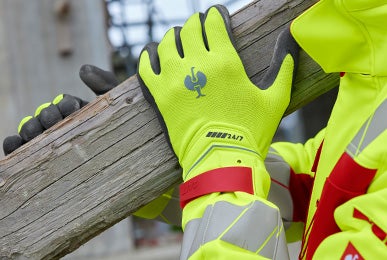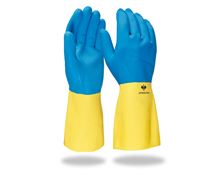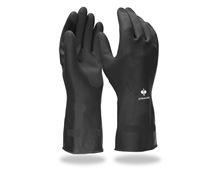



- EN 388:2016, Mechanical risks, 2131X
- EN 374-1:2016 - Typ A, chemical risks, AKLNOT
- EN ISO 374-5:2016, Chemicals and Micro Organisms
- Blue, roughened, extra thick latex coating
- Lined knitted cotton inside (100 %)
- Allow the gloves to be put on and taken off easily
- Very flexible but highly durable
- Optimum dry and wet grip properties
- Good cold and thermal insulation
- Perfect anatomical fit
- Application areas: Ideal for moderately difficult work in wet areas in the chemicals sector, farming and cleaning
- Length: approx. 29 cm
Important: The assessment is not a legally binding statement about the actual application suitability. For thisplease refer to the respective EN standards with the test code of the various gloves here in the text of the details screen.

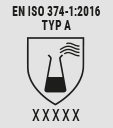
Full chemical protection TYP A
Full chemical protection gloves primarily aim to protect the hands against chemicals. They are assigned to the PSA Category III. Due to the infinite range of chemicals, there is no one specific glove that will offer protection against all liquids. Instead, the best product must be selected for the task at hand. Full chemical protection has a protection index of at least 2, i.e. a permeation time > 30 minutes for at least 6 of 12 statutory defined test chemicals. (Permeation = penetration on a molecular level).
TYPE A
Permeation performance at least level 2, >30 minutes against at least six chemicals in the list:
Testing Criteria:
A- Methanol
B- Acetone
C- Acetonitrite
D- Di-chloromethane
E- Carbon disulphide
F- Tuluol
G- Diethylamine
H- Tetrahydrofuran
I- Ethyl acetate
J- N-Heptane
K- Sodium hydroxide 40 %
L- Sulphuric acid 96 %
M- Nitric acid 65 %
N- Acetic acid 99 %
O- Ammonium hydroxide 25%
P- Hydrogen peroxide 30 %
S- Hydrofloric acid 40 %
T- Formaldehyde 37 %

Food-safe
These gloves are suitable for contact with food in compliance with Regulation (EC) No. 1935:2004 (on materials and items intended to come into contact with food).
Please find detailed information in the data sheet.
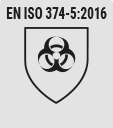
Microorganisms
It is usually assumed that protection gloves that withstand penetration in the test, offer effective protection against bacteria and fungi. However, because many viruses are much smaller than bacteria and fungi, these protection gloves may offer inadequate protection in practical fields.
A protection glove that is resistant to bacteria is a watertight glove that has a maximum AQL value of 1.5 in the permeability test. The AQL value (AQL = Acceptable Quality Level) reflects a given limit or the minimum quality requirement.
In general, the lower the AQL value, the better the quality of the protection gloves.
Protection against microorganisms:
Gloves that protect against bacteria and fungi. Not tested against viruses.
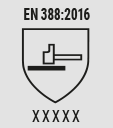
Mechanical risks
Protection gloves of this standard need to protect against physical and mechanical loads such as wear, cuts, puncturing, tearing or felling cuts. These loads can occur when working with metal or wood or any other tasks where hands need to be protected against mechanical injury. Also, they must comply with the regulations relating to electrical conductivity of protection gloves.
Protection gloves for mechanical risks must satisfy at least one of the test criteria listed in the table.
Testing Criteria:
Abrasion Resistance: 0-4
Cut Resistance: 0-5
Tear Resistance: 0-4
Puncture Resistance: 0-4
EN-ISO cut resistance: A-F
EN impact protection: yes/no
The higher the number (shown with an X below the icon in the example), the better the test result.
- good wet grip
- flexible and elastic
- waterproof
- for medium to heavy-duty work
Latex gloves offer excellent flexibility and tear-resistance as well as protection from fluids. The good wear properties make them ideal for light to medium work in dry and wet environments.
Latex – Very elastic and tear resistant. Very good gloves for medical work and food processing sectors.
Price
Available colours
Available sizes
Glove application recommendation
Glove total length
Material / coating
Protection standard
Special properties
Extras

Full chemical protection TYP A
Full chemical protection gloves primarily aim to protect the hands against chemicals. They are assigned to the PSA Category III. Due to the infinite range of chemicals, there is no one specific glove that will offer protection against all liquids. Instead, the best product must be selected for the task at hand. Full chemical protection has a protection index of at least 2, i.e. a permeation time > 30 minutes for at least 6 of 12 statutory defined test chemicals. (Permeation = penetration on a molecular level).
TYPE A
Permeation performance at least level 2, >30 minutes against at least six chemicals in the list:
Testing Criteria:
A- Methanol
B- Acetone
C- Acetonitrite
D- Di-chloromethane
E- Carbon disulphide
F- Tuluol
G- Diethylamine
H- Tetrahydrofuran
I- Ethyl acetate
J- N-Heptane
K- Sodium hydroxide 40 %
L- Sulphuric acid 96 %
M- Nitric acid 65 %
N- Acetic acid 99 %
O- Ammonium hydroxide 25%
P- Hydrogen peroxide 30 %
S- Hydrofloric acid 40 %
T- Formaldehyde 37 %

Food-safe
These gloves are suitable for contact with food in compliance with Regulation (EC) No. 1935:2004 (on materials and items intended to come into contact with food).
Please find detailed information in the data sheet.

Microorganisms
It is usually assumed that protection gloves that withstand penetration in the test, offer effective protection against bacteria and fungi. However, because many viruses are much smaller than bacteria and fungi, these protection gloves may offer inadequate protection in practical fields.
A protection glove that is resistant to bacteria is a watertight glove that has a maximum AQL value of 1.5 in the permeability test. The AQL value (AQL = Acceptable Quality Level) reflects a given limit or the minimum quality requirement.
In general, the lower the AQL value, the better the quality of the protection gloves.
Protection against microorganisms:
Gloves that protect against bacteria and fungi. Not tested against viruses.

Mechanical risks
Protection gloves of this standard need to protect against physical and mechanical loads such as wear, cuts, puncturing, tearing or felling cuts. These loads can occur when working with metal or wood or any other tasks where hands need to be protected against mechanical injury. Also, they must comply with the regulations relating to electrical conductivity of protection gloves.
Protection gloves for mechanical risks must satisfy at least one of the test criteria listed in the table.
Testing Criteria:
Abrasion Resistance: 0-4
Cut Resistance: 0-5
Tear Resistance: 0-4
Puncture Resistance: 0-4
EN-ISO cut resistance: A-F
EN impact protection: yes/no
The higher the number (shown with an X below the icon in the example), the better the test result.
- good wet grip
- flexible and elastic
- waterproof
- for medium to heavy-duty work
Latex gloves offer excellent flexibility and tear-resistance as well as protection from fluids. The good wear properties make them ideal for light to medium work in dry and wet environments.
Latex – Very elastic and tear resistant. Very good gloves for medical work and food processing sectors.
- Very good wet and dry grip
- Good dexterity
- For fine to heavy-duty work

Full chemical protection TYP A
Full chemical protection gloves primarily aim to protect the hands against chemicals. They are assigned to the PSA Category III. Due to the infinite range of chemicals, there is no one specific glove that will offer protection against all liquids. Instead, the best product must be selected for the task at hand. Full chemical protection has a protection index of at least 2, i.e. a permeation time > 30 minutes for at least 6 of 12 statutory defined test chemicals. (Permeation = penetration on a molecular level).
TYPE A
Permeation performance at least level 2, >30 minutes against at least six chemicals in the list:
Testing Criteria:
A- Methanol
B- Acetone
C- Acetonitrite
D- Di-chloromethane
E- Carbon disulphide
F- Tuluol
G- Diethylamine
H- Tetrahydrofuran
I- Ethyl acetate
J- N-Heptane
K- Sodium hydroxide 40 %
L- Sulphuric acid 96 %
M- Nitric acid 65 %
N- Acetic acid 99 %
O- Ammonium hydroxide 25%
P- Hydrogen peroxide 30 %
S- Hydrofloric acid 40 %
T- Formaldehyde 37 %

Food-safe
These gloves are suitable for contact with food in compliance with Regulation (EC) No. 1935:2004 (on materials and items intended to come into contact with food).
Please find detailed information in the data sheet.

Microorganisms
It is usually assumed that protection gloves that withstand penetration in the test, offer effective protection against bacteria and fungi. However, because many viruses are much smaller than bacteria and fungi, these protection gloves may offer inadequate protection in practical fields.
A protection glove that is resistant to bacteria is a watertight glove that has a maximum AQL value of 1.5 in the permeability test. The AQL value (AQL = Acceptable Quality Level) reflects a given limit or the minimum quality requirement.
In general, the lower the AQL value, the better the quality of the protection gloves.
Protection against microorganisms:
Gloves that protect against bacteria and fungi. Not tested against viruses.

Mechanical risks
Protection gloves of this standard need to protect against physical and mechanical loads such as wear, cuts, puncturing, tearing or felling cuts. These loads can occur when working with metal or wood or any other tasks where hands need to be protected against mechanical injury. Also, they must comply with the regulations relating to electrical conductivity of protection gloves.
Protection gloves for mechanical risks must satisfy at least one of the test criteria listed in the table.
Testing Criteria:
Abrasion Resistance: 0-4
Cut Resistance: 0-5
Tear Resistance: 0-4
Puncture Resistance: 0-4
EN-ISO cut resistance: A-F
EN impact protection: yes/no
The higher the number (shown with an X below the icon in the example), the better the test result.
- good wet grip
- flexible and elastic
- waterproof
- for medium to heavy-duty work
Latex gloves offer excellent flexibility and tear-resistance as well as protection from fluids. The good wear properties make them ideal for light to medium work in dry and wet environments.
Latex – Very elastic and tear resistant. Very good gloves for medical work and food processing sectors.


